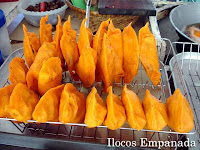
I found myself on the way to Ilocos Norte again for our Ultimate Philippines tour of the north! The first leg of the trip involved a long drive from Makati all the way to Blue Lagoon (Mairaira Cove) in Pagudpud, Ilocos Norte. With stopovers, the trip took 20 hours.
We left Makati 11 p.m. the night before and arrived in La Union at 6 a.m. for breakfast. Oasis Country Resort has a 24-hour restaurant beside the hotel which is very convenient for travelers.

After breakfast, we went straight to our first stop, the Sabangan Cove Weaving Village in Santiago, Ilocos Sur which was two hours away. When you near the town proper of Santiago, watch out for signs pointing to Santiago Cove. The weaving village is where some of the higher-quality abel iloko cloth is woven. Ask around for the house of the barangay captain where many of the looms are located.

From Santiago, we drove over to Santa Maria, Ilocos Sur to visit the Sta. Maria Church, a UNESCO World Heritage Site which was inscribed as part of the Baroque Churches of the Philippines.

I was quite surprised vendors were selling grapes at Php25 a bag by the church. It turns out, these are grapes that are grown locally in Ilocos Sur. They're a bit small will large seeds bu sweet nonetheless. I wonder if a wine industry will follow.

We made another long drive to Batac, Ilocos Norte for a quick snack stop at Glory's Empanada. It's about two hours from Sta. Maria. For me, the best Ilocos empanada is the one served in Batac. Near the empanadahan is the Marcos Mausoleum where the preserved body of President Ferdinand E. Marcos lies in state.

We had a late lunch in Herencia Cafe in Paoay, Ilocos Norte which is most know for its Pinakbet Pizza, Dinuguan Pizza, Bagnet Pizza and other fusion and traditional Ilocano dishes. In front of the restaurant is the Paoay Church, a majestic example of Philippine Baroque architecture, and another UNESCO-inscribed church.

Our last two stops for the day were the Cape Bojeador Lighthouse, a National Cultural Treasure, and the Bangui Wind Farm Project or the Bangui Windmills.
There were just too many people in the Cape Bojeador Lighthouse. I think it's about time they charge a little entrance fee to help in its upkeep and preservation with crowds wearing out this cultural treasure. There aren't even any restrooms.
For the Bagui Windmills, most people only pass by the view deck. But you could actually drive down to the beach for a better and close-up view of this massive sustainable energy project.

We arrived at the Kapuluan Vista Resort in Pagudpud, Ilocos Norte at about 7 p.m. just in time for a sumptuous buffet dinner. The main dish was Kahlua Pig, which is pork cooked the traditional Hawaiian way, wrapped in banana leaves and buried in a pit of hot charcoal under the sand. We also had salads, grilled chicken, marlin kilawin and seafood sisig among other stuff.
Part 2: Road trip from Pagudpud to Vigan
Part 3: Arce Mansion in Vigan, a colonial Ilocano dinner experience
Part 4: Historic Town of Vigan, a UNESCO World Heritage Site
Part 5: Tres de Mayo Festival in Vigan, Ilocos Sur
Part 6: Where to stay in Vigan (Hotels & Accommodation)


















